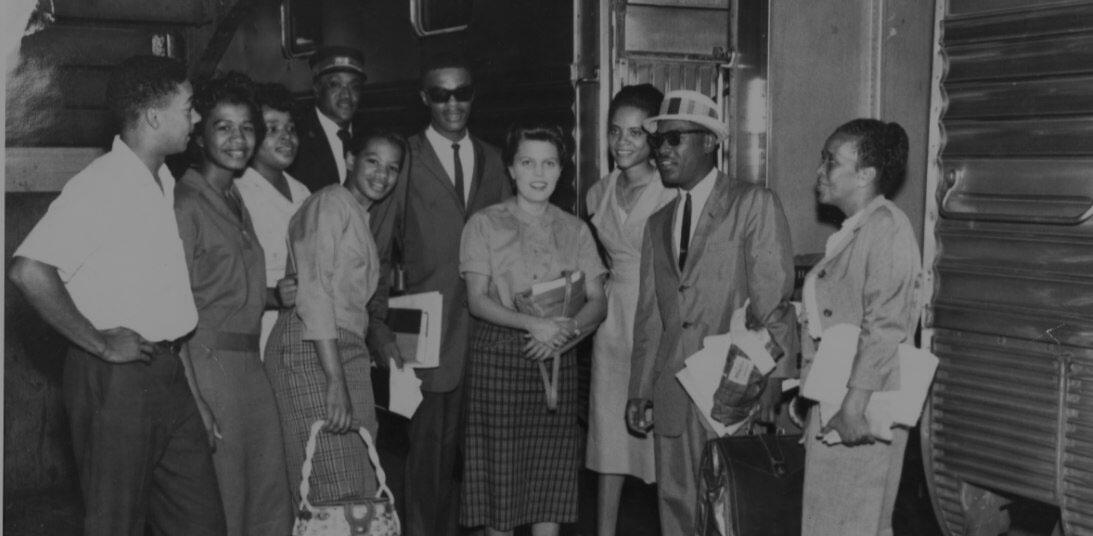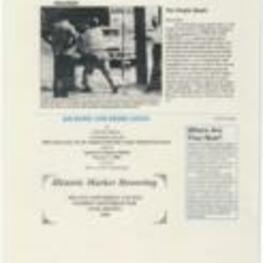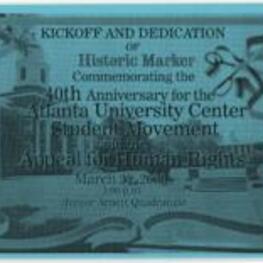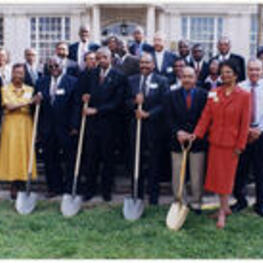2000-04-01
A newspaper article was written in the Atlanta Inquirer on April 1st, 2000. The article was an invitation and commemoration to the 40th Anniversary of the Atlanta University Center Student Movement and the Appeal for Human Rights on March 31st,2000. The four-page article summarizes the Appeal for Human Rights and the protest against discrimination in various areas, including education, jobs, housing, voting, healthcare, and entertainment, and states that the practice of racial segregation is incompatible with democracy and Christianity. 4 pages.
African Americans--Civil rights, African American student movements, Groups and organizations, African American leadership, African American universities and colleges
Mary Ann Smith Wilson, Ruby Doris Smith Robinson Collection on Student Activism
2000-03-31
Committee on the Appeal for Human Rights
A flyer for the commemoration event of the 40th anniversary of the Atlanta University Center Student Movement and the Appel for Human Rights held at Trevor Arnett Quadrangle. 1 page.
African Americans--Civil rights, African American student movements, Groups and organizations, Special eventss, African American universities and colleges
Mary Ann Smith Wilson, Ruby Doris Smith Robinson Collection on Student Activism
2000
People celebrate at an Atlanta Student Movement 40th Anniversary event. Featured figure: Mary Ann Smith, Morehouse President Walter E. Massey, Clark Atlanta University President Thomas W. Cole, and Lonnie C. King standing in-front of Trevor Arnett Hall.
African Americans--Civil rights, African American pioneers, African American student movements, Groups and organizations, African American universities and colleges, African American civil rights workers
Mary Ann Smith Wilson, Ruby Doris Smith Robinson Collection on Student Activism
2000
Committee on the Appeal for Human Rights
A schedule of events for the 40th-anniversary commemoration event of "An Appeal For Human Rights" and The Atlanta Student Movement from March 31st to April 2nd, 2000 at the Atlanta University Center. 2 pages.
African Americans--Civil rights, African American student movements, Groups and organizations, Special eventss, African American universities and colleges
Mary Ann Smith Wilson, Ruby Doris Smith Robinson Collection on Student Activism
1991-03-12
Committee on the Appeal for Human Rights
A thank you letter from Brenda to the Committee on the Appeal for Human Rights (COAHR) for participation in the committee. Cole reminds members that there will be another meeting held on March 24th, 1991 at the Woodruff Library. The meeting is to create a combined draft for a new appeal. 1 page.
African Americans--Civil rights, African American pioneers, African American student movements, Groups and organizations, African American universities and colleges
Mary Ann Smith Wilson, Ruby Doris Smith Robinson Collection on Student Activism
1990-11
Committee on the Appeal for Human Rights
Clark Atlanta University Inside Newsletter. The newsletter publication highlights concerns and news for students and faculty. Also featured is a timeline of Atlanta University. The invitation for the Atlanta University Center's 30th Anniversary Salute is shown in the newsletter. 4 pages.
African Americans--Civil rights, African American pioneers, African American student movements, Groups and organizations, African American universities and colleges, College student newspapers and periodicals
Mary Ann Smith Wilson, Ruby Doris Smith Robinson Collection on Student Activism
1960-11-02
Atlanta Student Movement
Sign in sheet from an Atlanta Student movement meeting. 1 page.
African Americans--Civil rights, African American pioneers, African American student movements, Groups and organizations, African American universities and colleges
Mary Ann Smith Wilson, Ruby Doris Smith Robinson Collection on Student Activism
1960-10
Student Nonviolent Coordinating Committee
An identification card for the SNCC (Student Nonviolent Coordinating Committee) fall conference. The conference was held from October 14th to 16th, 1960. The card asks for an individual's name, school affiliation, organization, home address, and workshop number. 1 page.
African Americans--Civil rights, African American student movements, Groups and organizations, African American students, African American universities and colleges
Mary Ann Smith Wilson, Ruby Doris Smith Robinson Collection on Student Activism
1960-07-20
Student Nonviolent Coordinating Committee
This is a submitted statement from The Student Nonviolent Coordinating Committee (SNCC) to the Subcommittee on Civil Rights and Immigration of the National Republican Convention. The written statement discusses the grievances against racial segregation and unequal treatment of African Americans. The statement petitioned the Republican party for legislative cooperation with SNCC and a civil rights political platform. Further, the statement lists Black voters' needs: education, employment, voting, and legal protection. A key figure mentioned is Marion S. Barry. 12 pages.
African Americans--Civil rights, African American student movements, Groups and organizations, African American students, African American universities and colleges, African American mayors, African Americans--Politics and government
Mary Ann Smith Wilson, Ruby Doris Smith Robinson Collection on Student Activism
1960-05
Student Nonviolent Coordinating Committee
This document contains the minutes and reports document from the first meeting of the Temporary Student Nonviolent Coordinating Committee (SNCC) from May 13-14, 1960, with Marion S. Berry, Jr. as the chairman and James Thomas as the secretary. The document offers the attendance and agenda, the statement of purpose for SNCC, committee reports, and drafted press releases. Key figures mentioned: Dr. Martin Luther King Jr, Lonnie C. King, Ella Baker, and Marion S. Barry. 11 pages.
African Americans--Civil rights, African American student movements, Groups and organizations, African American students, African American universities and colleges, African American mayors
Mary Ann Smith Wilson, Ruby Doris Smith Robinson Collection on Student Activism
1960-04
Southern Christian Leadership Conference
This document for the student conference at Shaw University, explores the psychology behind non-violent resistance, comparing it to the principles of Jiu-jitsu. It describes how non-violence and goodwill can cause an attacker to lose moral balance and feel insecure. The victim's kindness, generosity, and voluntary suffering pull the attacker forward, further destabilizing them. The document emphasizes that violence exhausts the attacker, and the appeals of a non-violent resister appeal to their more decent and kindly motives, creating a conflict within the attacker's personality. The presence of onlookers further affects the attacker's poise and perception of their conduct. The document asserts that when conducted openly, non-violent resistance can garner public support and react against the attacker. It highlights the advantages of the non-violent resister, including moral initiative, self-control, conservation of energy, and sincerity, which is seen as a powerful force. The refusal to use violence is seen as a sign of respect for the assailant's personality and moral integrity. 3 pages.
African Americans--Civil rights, African American student movements, Groups and organizations, African American students, African American universities and colleges
Mary Ann Smith Wilson, Ruby Doris Smith Robinson Collection on Student Activism
1960-04
Southern Christian Leadership Conference
This is a schedule of the "Youth Leadership Conference On Nonviolent Resistance" held at Shaw University, Raleigh, North Carolina. The program shows a three-day conference. Student leaders and activists converged at Shaw University to discuss and organize committees for the student sit-in movement, topics of protesting and picketing, the philosophy of nonviolence, and the legal implications of sit-in protest with the risk of jail. 4 pages.
African Americans--Civil rights, African American student movements, Groups and organizations, African American students, African American universities and colleges
Mary Ann Smith Wilson, Ruby Doris Smith Robinson Collection on Student Activism
1960-04
Southern Christian Leadership Conference
This document presents six fundamental aspects of nonviolence as outlined by Dr. Martin Luther King Jr. It emphasizes that nonviolent resistance is not for cowards and requires active spiritual engagement. Nonviolence seeks to win the friendship and understanding of opponents rather than defeat or humiliate them. The focus is on combating forces of evil, not individuals perpetrating evil. Nonviolent resisters are willing to accept suffering without retaliation and believe in the redemptive power of unearned suffering. Internal violence of the spirit, such as hate, is rejected in favor of love as the guiding principle. Nonviolent resistance is based on the conviction that the universe is on the side of justice, instilling faith in a future of cosmic companionship and universal wholeness. 2 pages.
African Americans--Civil rights, African American student movements, Groups and organizations, African American students, African American universities and colleges
Mary Ann Smith Wilson, Ruby Doris Smith Robinson Collection on Student Activism
1960-04
Southern Christian Leadership Conference
This document offers a firsthand account of the Dharasana Salt Satyagraha, where many volunteers in India protested against police regulations. Following Gandhi's principle of non-violence, the volunteers endured beatings without retaliating. The report emphasizes the discipline, determination, and refusal to disperse demonstrated by the volunteers, who viewed their injuries as martyrdom for the cause of Indian independence. The scenes witnessed were astonishing, defying the expectation of violence, and the reporter expresses feelings of disgust and emotional impact, having covered numerous civil disturbances and rebellions in the past. 2 pages.
African Americans--Civil rights, African American student movements, Groups and organizations, African American students, African American universities and colleges, African American mayors
Mary Ann Smith Wilson, Ruby Doris Smith Robinson Collection on Student Activism
















